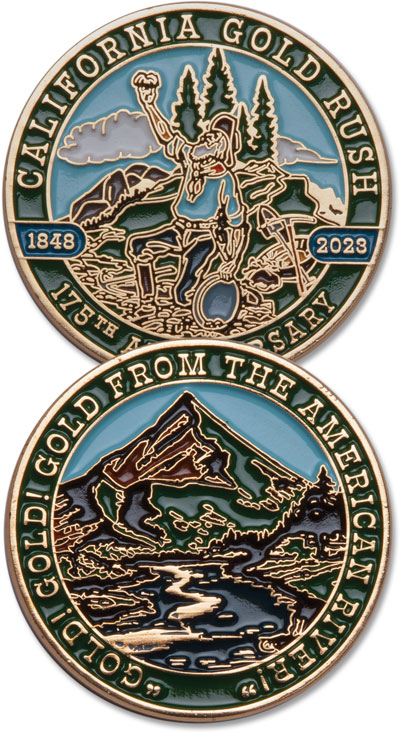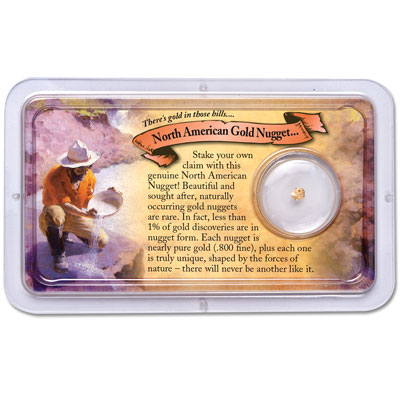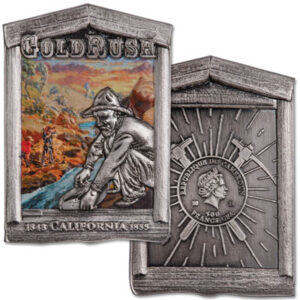Gold! Gold! Gold from the American River!

When gold was discovered in California in 1848, no one could have predicted the cascade of events that would change the course of American history.
Meet John Sutter, a self-proclaimed Swiss military captain. He left his wife and five children, plus debt behind in Europe. By most accounts, Sutter was a free-spending bon vivant. After forays across America, plus Hawaii and Alaska, he arrived in the north-central valley around 1841, just a few years ahead of the Mexican-American War. He secured a substantial land grant in the California Territory from Mexico’s provincial governor. Sutter named his spread Nueva Helvetia (Spanish for New Switzerland). To build a settlement, he needed a construction manager.
Enter James Marshall, a restless carpenter who learned his trade as a millwright in New Jersey. After joining other pioneers on the Oregon Trail, Marshall veered south into the Sierra Nevada foothills thick with Ponderosa pine and black oak. He signed on to oversee the crew that would build Sutter’s much-needed lumber mill on the American River.
Boys… I believe I’ve found a gold mine!
On January 24, 1848, Marshall was walking the channel below the nearly completed sawmill when a quick flash of light caught his eye. He bent down. About half the size and shape of a pea “[i]t made my heart thump, for I was certain it was gold,” he later recalled. His crew, however, was skeptical.

Marshall went to Sutter’s office. When tests revealed the presence of gold, the two men could barely curb their excitement. They kept the find a secret so Sutter could ask the Mexican governor for the mineral rights. But, he was too late. The Mexican-American War was over. On February 2, 1848, under terms of the Treaty of Guadalupe Hidalgo, the United States took control of the California territory.
By March, the discovery of gold was trickling into San Francisco newspapers. The Californian ran a small paragraph with a simple headline: Gold Mine Found. Ten days later, the California Star, reported: “So great is the quantity of gold taken from the mine recently found at New Helvetia, that it has become an article of traffic in that vicinity.”
Hopeful prospectors left their jobs to pan for gold around Sutter’s Mill. More would come. After all, the last gold rush had occurred in Georgia in 1829. Americans were ready for new prospecting opportunities!
…accounts of the abundance of gold…
It had been 20 years since America experienced the rush of mining for gold in the Appalachian foothills. That gold rush resulting in the minting of coins in a short-lived mint in North Carolina. Now, in 1849, a new gold rush was on with public attention turned to the California Territory, acquired in the Treaty of Guadalupe-Hidalgo, which ended the Mexican-American War.
“It was known that mines of the precious metals existed to a considerable extent in California at the time of its acquisition. Recent discoveries render it probable that these mines are more extensive and valuable than was anticipated,” President James K. Polk told Congress.
Thousands of eager prospectors left behind jobs and families in the East. San Francisco’s population waned briefly with a seeming mass exit inland to the North-Central Valley. Immigrants arrived by ship from China, Central and South America, and Europe to try their hand at looking for gold. Or, at least selling miners supplies and food. A bartender could charge a pinch of the bright yellow dust for a shot of hard liquor.
Lived a Miner, Forty Niner…
The Forty Niners took picks, shovels, pans, plus loaded rifles to protect every nugget and loose gold flake drifting downstream they discovered. Boomtowns rose from mining camps. Shouts of “Eureka!” filled the air. Maybe it was a nod to Archimedes. The Greek mathematician shouted “I found it!” when he realized how to measure gold’s weight by lowering the emperor’s gold crown into a container of water. Miners would name a California town Eureka and civic promoters would claim the word as the state motto.

The gold rush sped up both the process of getting a San Francisco assay office to test the purity of the mined ore as well as admission of the 31st state to the union. They occurred within months of each other in 1850. But transporting gold to U.S. mints back East was time-consuming and dangerous. With professionals from jewelers to private minters striking various gold coins for commerce, California’s businessmen lobbied hard for a branch mint that would follow a federal standard.
Finally, in 1853, the U.S. Treasury acquired and retrofitted the building of private coiner Moffat & Company. Within a year, the first San Francisco Mint opened with a press that could turn out 76 gold Liberty Head coins a minute. “S” mint mark was stamped on $1, $2.50, $5, $10 and $20 denominations. They are now among the most hard to find of California’s Gold Rush coins.
For its part, the San Francisco Mint quickly developed a reputation for superior striking capability – a status that remains to this day. What San Francisco Mint coins do you have in your collection?
SOURCES
The History Channel. “California Gold Rush.” Updated: August 10, 2022; original: April 6, 2010. Accessed February 14, 2023. https://www.history.com/topics/19th-century/gold-rush-of-1849
“Facts about John Sutter.” Accessed February 14, 2023. https://factinformer.com/facts/89/about-john-sutter/
California Department of Parks and Recreation. “Gold Rush Overview.” Accessed February 3, 2023. https://www.parks.ca.gov/?page_id=1081



